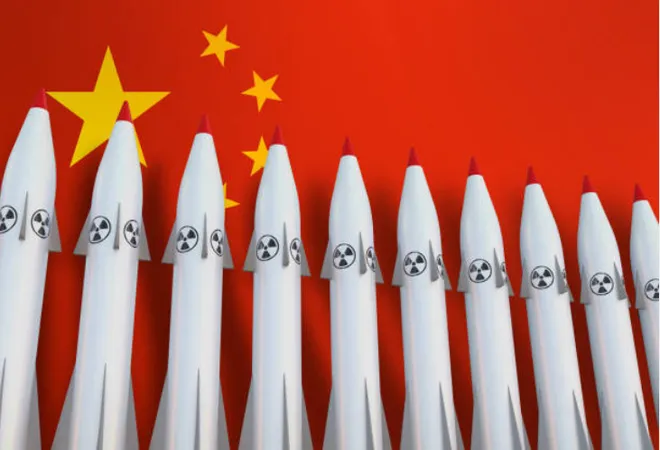 This is the 72nd article in the series
This is the 72nd article in the series The China Chronicles.
Read all the articles here.
India and China’s nuclear equation is seemingly benign — the two countries have never issued an overt nuclear threat to each other, nor have the two sides indulged in nuclear saber rattling. Both meet annually for strategic dialogues and discuss nuclear issues. There is also a great deal of doctrinal assurance whereby both sides maintain minimum arsenals for credible deterrence, pursue a policy of No First Use for nuclear weapons, and have extended negative security assurances to non-nuclear weapons states. This was evident during the two months long Doklam standoff in 2017 during which neither side issued a nuclear threat.
Chinese scholars often believe that India’s role is inconsequential in China’s nuclear calculus. China’s superiority in the nuclear and conventional military domain negates any deterrence vis-a-vis India. Moreover, given the fact that neither side has exchanged fire on their disputed border, it is unlikely that there will be a hot war between them. They further argue that much of China’s nuclear advancements is vectored towards the United States. China’s singular mission is to ensure that its retaliatory strike capabilities are adequately directed at the United States.
China’s superiority in the nuclear and conventional military domain negates any deterrence vis-a-vis India.
It is obvious why they find it
perplexing when the Indian strategic community raises concerns about China. Some Chinese scholars attribute it to India’s efforts to establish conventional superiority over Pakistan, especially given Pakistan’s deep security ties with China. Others relate it to India’s attempt to override domestic opposition to its nuclear weapons programme, which it is pursuing in its bid to become a global power. Regardless of the proffered narrative, the general view within China’s scholarship is that much of India’s concern with regard to China is imaginary and baseless.
The Chinese strategic community seemed particularly piqued when India conducted the fourth and the subsequent pre-operational tests of its long-range Agni V missile 2012 onwards, which has the capacity to reach beyond Tibet, to China’s heartland and northern frontiers. The spokesperson of the Chinese Foreign Ministry raised questions on the propriety of India’s nuclear missile programme by referring to the UN Security Council Resolution 1172 of 6 June 1998 (which incidentally is
non-binding on India). There are views among Chinese scholars that Indian nuclear weapons are
deployed against China and that India could pose security challenges in the future. The Chinese Communist Party-run propaganda paper
Global Times responded bitterly, targeting Western countries for their insouciance with regard to India’s status as a nuclear weapons state, and then pressing the case for Pakistan to have the privileges in nuclear development that India does.
The Chinese strategic community seemed particularly piqued when India conducted the fourth and the subsequent pre-operational tests of its long-range Agni V missile 2012 onwards, which has the capacity to reach beyond Tibet, to China’s heartland and northern frontiers.
Indeed, China has extensively supported Pakistan in developing its nuclear weapons capabilities. China
supplied Pakistan with nuclear material and expertise in the 1990s to help develop a plutonium production reactor and ring magnets for Pakistan’s enrichment programme. The
US congressional report published in August 2006 revealed China’s violation of the current Nuclear Suppliers Group (NSG) guidelines in selling nuclear reactors for Chasma-3 and Chasma-4 to Pakistan. China has also
peddled the designs and technology of its ‘M’ series of ballistic missiles to help Pakistan developed the medium-range ballistic missiles Shaheen I and II by violating the terms of the Missile Technology Control Regime (MTCR). Of late, China has sold modified Type 41 Yuan-class diesel-electric submarines to Pakistan, and there is a
growing concern that China might use the bases in Gwadar and Karachi for its own nuclear and conventional submarines.
India confronts a situation where China has not only provided Pakistan with designs and materials to develop nuclear weapons but has also given Pakistan the technologies and equipment for manufacturing missiles capable of carrying nuclear weapons to every part of India, including the Andaman Islands, which Pakistan has been ceaselessly utilising to target and threaten India. These developments are in violation of the MTCR and the NSG is guidelines.
They are also wrong when they blame India for disrupting the security situation in South Asia.
Therefore, Chinese scholars are wrong in their assessment of India’s concerns which they attribute to India’s sense of insecurity and its aspirations for great power status. They are also wrong when they blame India for disrupting the security situation in South Asia. India’s nuclear weapons programme has been developed in response to the diabolic Sino-Pak nuclear axis. Yet, India has advanced its nuclear programme with utmost restraint. Despite being a non-signatory to the Nuclear Non-Proliferation Treaty (NPT), India has followed policies consistent with the key provisions of NPT that apply to nuclear-weapon states. India has repeatedly demonstrated its commitment to creating a peaceful global order and has been able to gain the confidence of the international interlocutors.
India’s concerns with regard to China are neither imaginary nor baseless. India faces grave security challenges from Pakistan, and China has actively assisted the latter. China’s assistance to Pakistan’s nuclear weapons programme is the most consequential source of instability in the region.
The views expressed above belong to the author(s). ORF research and analyses now available on Telegram! Click here to access our curated content — blogs, longforms and interviews.



 This is the 72nd article in the series The China Chronicles.
Read all the articles
This is the 72nd article in the series The China Chronicles.
Read all the articles  PREV
PREV


